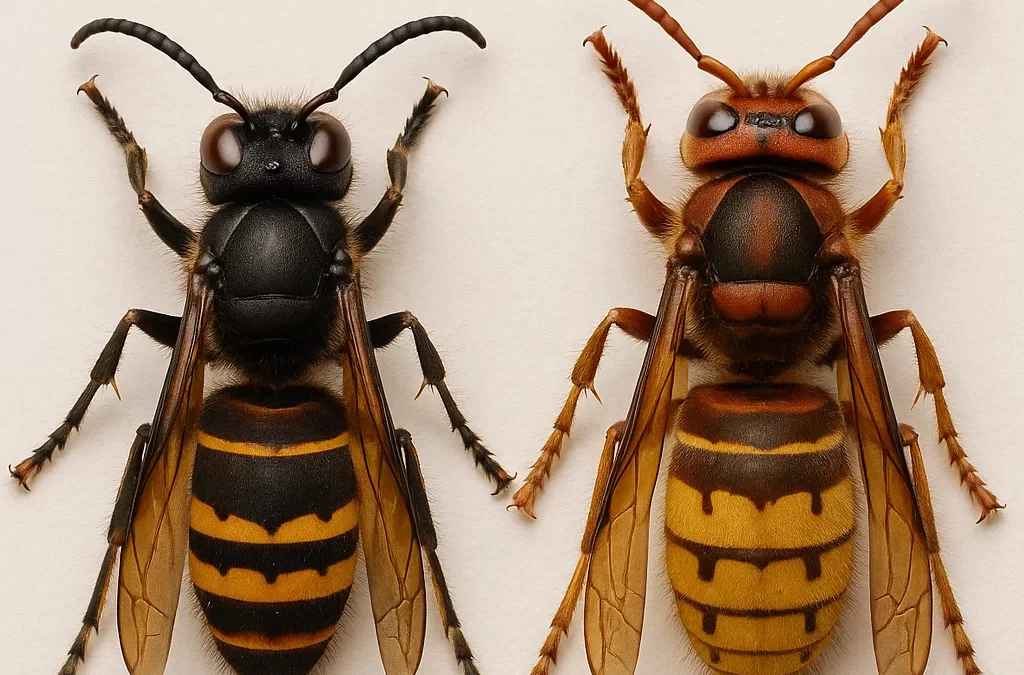(Including Swindon, Wiltshire, Oxfordshire & Gloucestershire)
As summer arrives and insects become more active across the South of England—including Swindon, Wiltshire, Oxfordshire, and Gloucestershire—there’s growing concern about the Asian hornet, an invasive species that poses a serious threat to our local environment and pollinators. Often mistaken for the native European hornet or even large wasps, knowing the difference is key to keeping your family, garden, and local bee populations safe.
Let’s break down how to identify each species, understand why Asian hornets are spreading in the UK, and what you should do if you think you’ve seen one.
🆚 Key Differences: Asian Hornet vs. European Hornet
| Feature | Asian Hornet (Vespa velutina) | European Hornet (Vespa crabro) |
|---|---|---|
| Size | Smaller – around 20mm (queen up to 30mm) | Larger – workers up to 25mm (queen up to 35mm) |
| Colour | Mostly black body with a yellow-orange band on the 4th segment, yellow legs | Reddish-brown thorax with a more yellow abdomen, legs brown |
| Behaviour | Aggressive predator of honeybees | Less of a threat to bees, generally avoids humans |
| Nest | Large, often high in trees or buildings | Also nests in trees, attics or sheds |
| Risk to Humans | Not aggressive unless threatened, but will defend the nest | Generally not aggressive |
While both hornets can look intimidating—especially if you’re used to seeing wasps in Wiltshire gardens—it’s the Asian hornet’s effect on pollinators that makes it especially dangerous.
🌍 How Did the Asian Hornet Arrive in the UK?
The Asian hornet was first introduced to Europe accidentally via imported goods in 2004. Since then, it has rapidly spread across the continent and into parts of southern England, including reported sightings near Swindon, Oxfordshire, and coastal areas.
➡️ Learn more from the UK Government’s APHA update on Asian hornets
➡️ See sightings in your area on the National Bee Unit’s map
🐝 Why Are Asian Hornets a Problem?
These invasive hornets are fierce predators of honeybees and native pollinators, which are already under threat from habitat loss and pesticide use. In regions like Wiltshire, Gloucestershire, and Oxfordshire, which support rich rural biodiversity and farmland, a decline in pollinators could have devastating consequences.
➡️ Read more from the British Beekeepers Association
🚨 Think You’ve Seen One in Swindon or Nearby?
If you’re in Swindon, Wiltshire, Oxfordshire, or Gloucestershire and think you’ve seen an Asian hornet or nest:
-
Do not approach the nest – Asian hornets may become aggressive if threatened.
-
Take a photo if it’s safe to do so – visual confirmation helps experts.
-
Report the sighting:
📱 Use the Asian Hornet Watch app
🌐 Or report online via the Non-Native Species Secretariat (NNSS) -
Contact a local pest control expert – especially if you find a nest near your home or business. Trained professionals in Swindon, Gloucestershire, and across Wiltshire and Oxfordshire can safely remove nests.
➡️ Contact Pestcatcher Pest Control qualified pest control experts in Swindon on 01793 630768
✅ Final Word
Whether you’re in Swindon, the Cotswolds, Oxfordshire’s countryside, or urban Wiltshire, it’s essential to stay alert during the warmer months. By recognising the signs and taking action, you can help prevent the spread of the Asian hornet—and protect our precious pollinators.
Stay vigilant. Don’t disturb nests. And if in doubt—call Pestcatcher on 01793 630768






